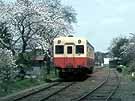
A train is pulling into Takataki station, rolling under a cherry blossom. In April, the line is blessed with many cherry blossoms blooming alongside the tracks.
 |
|
A train is pulling into Takataki station, rolling under a cherry blossom. In April, the line is blessed with many cherry blossoms blooming alongside the tracks.
|
Click here to see the rail map of the Boso Peninsula.
Passengers are commuters to Chiba and Tokyo and tourists exploring
Yoro Keikoku (valley). Most areas along the line are countryside. Views
from the window are full of nature. You can enjoy typical Japanese
local scenes and four seasons with cherry blossoms in spring, green
mountains in summer, colorful leaves in autumn, and frosty fields in
winter. Most of the train stations have small old houses, but they are
very well preserved.
Click here to see the track map of the Kominato Railway.
Kominato Tetsudo has not been electrified. There exist 14 type 200
diesel cars, which were built from 1961 to 1977. The side view of the
200 is basically the same as the Kiha 20 of JR. The cars built in 1975
and 1977 have unit type windows. Their size is 20,000 mm long, 2903
wide, and 3880 high. The highest speed is 95km with a 180/1500ps/rpm
engine (DMH17C). The traditional cream yellow and orange livery, which
was also the same as that of former JNR diesel cars, has been unchanged.
The depot is located at Goi. It should be noted that three classic
steam
tank engines which used to run on the line are preserved in the depot.
Two of them were built by Baldwin and the other by Peacock.
At any rate Kominato Tetsudo is very attractive and nostalgic.
Railmen of Kominato Tetsudo look very proud of their railway. It is
said that they make every effort to keep its attractiveness. In fact,
you can find well-kept old cherry trees here and there along the line.
In addition, it is situated near Tokyo. It takes around one hour from
Tokyo station to Goi by Kaisoku (rapid train) without extra charge.
While trains run more often than every hour between Goi and
Kasusa-Ushiku, there are only ten trains going further than
Kazusa-Ushiku a day. Needless to say, the section between Kausa-Ushiku
and Kazusa-Nakano is more scenic. Please check the timetable carefully,
and enjoy your trip!